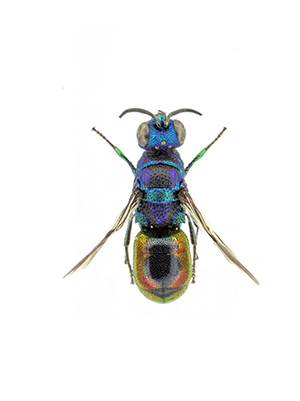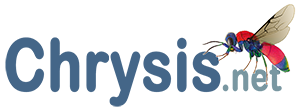Last updated on November 28th, 2023
 From: Kimsey L.S. & Bohart R.M., 1990 (1991) – The chrysidid wasps of the world. Oxford University Press, ix-652 pp.
From: Kimsey L.S. & Bohart R.M., 1990 (1991) – The chrysidid wasps of the world. Oxford University Press, ix-652 pp.
Synonymy
Philoctetes Abeille 1879:27. Type: Holopyga cicatrix Abeille 1879 (Diplorrhos micatus Kimsey). Desig. by Ashmead 1902:228.
Diplorrhos Aaron 1885:216. Type: Diplorrhos plicatus Aaron 1885:216. Monobasic. N. synonymy.
Chrysellampus Semenov 1932:5. Type: Chrysellampus heros Semenov 1892:71. Orig. desig. and monobasic. N. synonymy.
Dictenulus Semenov 1932:6. Type: Ellampus specularis Semenov 1932:18. Orig. desig. N. synonymy.
Parellampus Semenov 1932:7. Type: Parellampus praeteritorium Semenov 1932:7.
Generic diagnosis
Scapal basin generally smooth and asetose; malar space 1 MOD or shorter; genal carina generally faint, extending from mandibular socket; vertex generally densely punctate; pronotum deeply concave laterally, punctate medially; scutum with punctures clumped along notauli, or less commonly more evenly distributed; mesopleuron carinate or rounded, juncture of omaulus, verticaulus, and scrobal carina not strongly projecting, signum carina usually present, scrobal sulcus oblique; metanotum usually conical, even mucronate in several species; fore wing medial cell asetose, medial vein strongly arched and arising before cu-a, stigma short, broad and apically rounded; fore femur carinate ventrally; tarsal claws with 1-3 subsidiary teeth; T- I—III strongly convex; T-III lateral margin straight: or sinuate, usually deeply notched apicomedially, or bent under, without transparent rim.
Hosts
Philoctetes variatus has been reared from various twig-nesting Pemphredoninae (Sphecidae), including Diodontus occidentalis W. Fox, Pemphredon grinnelli (Roh.), Stigmus inordinattis W. Fox, and Passaloecus cuspidatus F. Smith (Powell 1963, Parker and Bohart 1966, Evans 1973b). Philoctetes intermedium has been reared from Diodontus virginianus (Roh.) (Krombein 1963).
Distribution
The majority of species are Holarctic, with 8 in the Nearctic Region and 34 in the Palearctic. One unusual species, afer, is Afrotropical. The highest diversity is in southern USSR and western China.
Discussion
As a whole, Philoctetes is the least specialized of the three genera related to Omalus, although it does include some highly derived species. The mesopleuron usually has an omaulus, scrobal carina, and verticaulus. However, one or more of these carinae may be weakly developed or even absent. In addition, the tarsal claws only have one to three subsidiary teeth, with most species having two. Diagnostic features are: omaulus and scrobal carina forming a broadly V-shaped angle, scutal punctures clumped along notauli, and metanotum usually sharply angled, or even mucronate. A mucronate metanotum occurs in cupratus, afer, and seminudus. Several species, including intermedium, have an Elampus-like snout on the apex of T-III. Most species have T-III notched apicomedially. This notch may be simple or snout-like, as in intermedius, or have a dorsal nose-like projection as in plicatus and downeyi. Other species, including hirsutus and nikolskyi, have extensive long, erect, black setae. One group, including caudatus, deflexus, fedtsbenkoi, limpidipennis, and omaloides, has the metanotum sharply conical and the apex of T-III is bent under giving it a nose-like appearance, without a medial notch.
We have used somewhat different characters to define Philoctetes than previous authors, and as a result the Philoctetes of Linsenmaier (1959) is not comparable. There are no major revisions of this group, and the only reliable regional treatments are those of Bohart and Campos (1960) and Bohart and Kimsey (1982), where it is given as Diplorrhos.
European species
- Philoctetes abeillei Buysson (in André), 1893
- Philoctetes bidentulus (Lepeletier, 1806)
- Philoctetes bogdanovii (Radoszkovski, 1877)
- Philoctetes bogdanovii unicolor (Trautmann, 1926)
- Philoctetes canariensis (Mercet, 191)5
- Philoctetes caudatus (Abeille, 1878)
- Philoctetes caudatus ortegai (Linsenmaier, 1993)
- Philoctetes chobauti (Buysson, 1896)
- Philoctetes cicatrix (Abeille, 1878)
- Philoctetes deflexus (Abeille, 1878)
- Philoctetes dusmeti (Trautmann, 1926 )
- Philoctetes friesei (Mocsáry, 1889)
- Philoctetes helveticus (Linsenmaier, 1959)
- Philoctetes horvathi (Mocsáry, 1889)
- Philoctetes horvathi inflammatus (Mocsáry, 1890)
- Philoctetes kuznetzovi (Semenov, 1932)
- Philoctetes micans (Klug, 1835)
- Philoctetes omaloides Buysson, 1888
- Philoctetes parvulus (Dahlbom, 1854)
- Philoctetes perraudini (Linsenmaier, 1968)
- Philoctetes punctulatus (Dahlbom, 1854)
- Philoctetes putoni (Buysson, 1891)
- Philoctetes sareptanus (Mocsáry, 1889)
- Philoctetes tenerifensis Linsenmaier, 1959
- Philoctetes truncatus (Dahlbom, 1831)
- Philoctetes wolfi (Linsenmaier, 1959)
Copyright, Authorship, and Ownership statements
All text and images of this page are copyright ©️ Chrysis.net unless otherwise stated - please see individual cases for authorship and copyright details. The specimens pictured are from the authors' or other collaborators' personal collections and from the collections of various museums. Unless otherwise specified, the whole content of this web site is for personal, non-commercial, scientific, and educational purposes given proper accreditation to the page from which they were derived are provided, and under Chrysis.net Terms and Conditions.
For citation purposes
Agnoli G.L. & Rosa P. (2025) Genus Philoctetes Abeille, 1879, in: Chrysis.net website. Interim version 05 July 2025, URL: https://www.chrysis.net/database/genus-philoctetes/.




